Top News
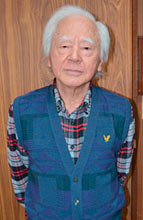
January 6, 2014 Ryukyu Shimpo
The Miyako Dialect Promotion Group surveyed elementary and junior high school students in Taira City about the Miyako dialect. More than 90 percent of the respondents answered that they “do not use” or “rarely use” Myaku utsu or the Miyako dialect. The survey revealed the young generation tended not to use the dialect.
The organization carried out the survey last November aimed at 5th grade pupils from 11 elementary schools and second grade students from six junior high schools in the former Hirara City. About 800 students responded to the survey.
To the question of whether they use the dialect regularly, 6 percent of the elementary school pupils and 4 percent of the junior high school students answered that they often use it. About 50 percent of the elementary school pupils and junior high school students answered that they sometimes use it. To the question of how much they understand the dialect, 2 percent of the students answered that they understand it well. Sixty percent of the elementary school pupils and 50 percent of the junior high school students answered that they understand it a little.
Asked to translate Japanese into the dialect, 50 percent of them did this correctly. They said “tandigaa tandi” for “thank you.” One or two percent of them said “aagu” for “song.” Asked to translate the dialect to Japanese, 14 to 15 percent of them said “health” for “ganzu.” Many questions got correct answers in less than ten percent. The organization chair Tsutomu Sadoyama pointed out that the respondents who answered that they often use the dialect or slightly understand it, cannot actually use it. He commented, “This shows the promotion of the dialect needs to start again from the beginning.”
Meanwhile, 55 percent of the elementary school pupils and 43 percent of the junior high school students replied that do not want to lose the dialect.
Sadoyama said, “Although parents should use the dialect at home to make their children familiarize with it, the parents cannot speak it either. We need to encourage conversation in the dialect by presenting specific examples.”
(English translation by T&CT and Megumi Chibana)
Go to Japanese
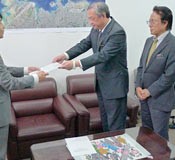
January 10, 2014 Ryukyu Shimpo
The Okinawa Prefectural Government (OPG) and the Naha Port Authority approved the landfill for extending the runway of Naha Airport on January 9. The Okinawa General Bureau, Cabinet Office, has submitted the landfill application. According to the plan, the construction work will start this month and will be completed in December 2019. The new runway will operate from the end of March 2020. The flight system for accepting the visitors from home and abroad will be strengthened. The OPG aims to add momentum to achieve the goal of attracting 10 million tourists per year.
The Okinawa General Bureau submitted the landfill application in last September. The OPG and the Naha Port Authority approved the landfill application because it meets the standards of the Public Water Body Reclamation Act. The government has shown a plan for transplanting valuable seagrass beds and coral.
Koji Kohirata, the Director of Development Construction Department of the Okinawa General Bureau, emphasized, “This project is essential for achieving the 10 million tourist plan. We want to do this in time for the 2020 Tokyo Olympics.”
The total project cost is about 199.3 billion yen. The total budget in fiscal year 2013 is 13.7 billion yen, of which the government pays 13 billion yen. The construction will move into full swing from February this year. The planned budget in fiscal 2014 will be 34.7 billion yen, of which the government will bear 33 billion yen. Upon approval, the OPG asked the government for environmental protection measures and to disclose the results of aircraft noise surveys. It also requested that the government to coordinate with the local municipalities if new measures are needed after the runway operates. The General Bureau concluded a fisheries compensation contract with five fishing cooperatives including the Naha Coastal Fisheries Cooperative on January 9.
(English translation by T&CT)
Go to Japanese
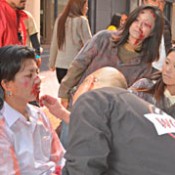
January 6, 2014 Ryukyu Shimpo
About 40 people turned into zombies by special makeup effects in the First Commercial Avenue in Okinawa City on December 28. They will appear in Haisai Zombie, a short film that the Okinawa City KOZA Film Office creates.
Yoshihiro Nishimura, who has been working as a special effects make-up artist for several movies, and his four assistants put special make-up on movie extras selected from applicants.
The extras wore ripped clothes with red paint. Nishimura and his assistants made their faces up with grey greasepaint and alcohol paint. They then painted the extras’ nails black.
After having their makeup done, the extras looked at one another and took photographs. Satoko Tamanaha who took part in the shooting with her friend, said, “I am excited. I want to go back home with the makeup.”
(English translation by T&CT)
Go to Japanese
January 10, 2013 Ryukyu Shimpo
The Okinawa Prefectural Assembly held an extraordinary session in the evening of January 10. The majority of the assembly members approved the resolution to demand that Okinawa Governor Hirokazu Nakaima resign. In the resolution, they protested against Nakaima’s approval of the Henoko landfill to prepare to move the U.S. Marine Corps Air Station Futenma. The members blamed him for violating his pledge to move the base outside Okinawa. Opposition parties, the neutral faction Souzo and the ruling Liberal Democratic Party coalition partner Komeito favored the resolution.
This is the first time since Okinawa’s reversion to Japan that the prefectural assembly has passed a resolution demanding that the governor resign.
The opposition parties proposed the resolution. They pointed out that the governor violated his pledge made in the gubernatorial election campaign because he approved the government’s application for the landfill. The parties blamed the governor for ignoring the resolution unanimously approved by the assembly. In this resolution, they opposed moving the base inside the prefecture, and demanded it outside Okinawa or Japan.
The resolution did not discuss about the pros and cons of Henoko relocation.
Before the resolution, most of the assembly members made up of the opposition parties and Komeito approved the written opinion. It asked the Japanese government to cancel the relocation, and to swiftly close and remove the base.
(English translation by T&CT)
Go to Japanese
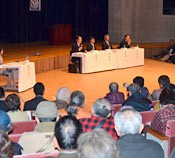
January 12, 2014 Ryukyu Shimpo
Tokyo based think tank the New Diplomacy Initiative held a symposium on the theme, “Rethinking the relocation of the US Futenma Air Station to Henoko,” at the Nago Civic Hall on January 10. This think tank makes diplomacy policy recommendations to both the governments of Japan and the United States. Kyoji Yanagisawa, the former assistant deputy chief cabinet and former senior official at the defense ministry, gave a lecture on the controversial US military presence in Japan that functions as a deterrent against China’s growing military power. “There is friction as though people are running in the same direction all at once during rush hour. However, there is not a threat that you cannot save yourself without destroying your opponents,” Yanagisawa commented. “The logic behind the argument that the U.S. forces staying there has a deterrent effect is not rational.”
Questioning the role of the U.S. Marine Corps on Okinawa as a deterrent, he asserted that in military circles there are possible scenario that would allow the Marines on the Futenma base to move outside Okinawa. “It is the role of politics to achieve it for the benefit of the residents,” he stressed. Referring to the idea that the governments will move the base from Futenma to Henoko, he said, “This is the same thinking as the U.S. bases in Japan having been concentrated in Okinawa because the anti-base struggle has intensified in the mainland of Japan. As long as the government does not stop the cycle of pressing problems on a location where there is less resistance from the residents, Okinawan people must live in among bases.”
Hiromori Maedomari, professor at Okinawa International University, said, “The central government tax revenues and national treasury disbursement are allocated to local governments across the country. That is money that all local governments can get as a matter of normal process. Why does the central government allocate these funds to Okinawa only in exchange for accepting the military base? Why do they threat us like this?”
In a video message, Mike Mochizuki, professor at George Washington University, pointed out that the U.S. Marine Corps will redeploy its troops to Guam, Hawaii and the U.S. mainland from Okinawa in the long term, and stressed that it is not necessary to put a full-blown permanent base in Okinawa.
(English translation by T&CT)
Go to Japanese
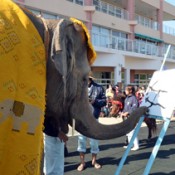
January 3, 2014 Ryukyu Shimpo
On January 2, the Indian elephant Ryuka tried kakizome or first calligraphy at the Okinawa Zoo & Museum. She wrote this year’s Chinese zodiac sign of Horse in kanji, holding a special customized brush for calligraphy with her trunk. In tribute to this year’s Chinese zodiac, the Yonaguni horse Dunan and Navie signed the works by Ryuka with their signature hoof prints in red color.
The zoo gave the elephant and horse-signed works as New Year presents to the visitors born in the Horse year.
Maiko Tome, 11-year-old pupil of Kitami Elementary School who visited with her family, said, “I was surprised to see how Ryuka wrote a great and strong kanji so well.”
Their kakizome will be displayed at the special exhibition gallery until the end of this month.
(English translation by T&CT and Hitomi Shinzato)
Go to Japanese
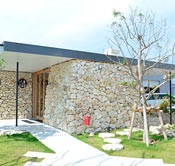
January 6, 2014 Ryukyu Shimpo
Itoman Fishers Restaurant in the Nishizaki district of Itoman received the JCD Design Award and Good Design Award for fiscal 2013.
In the fishing village of Itoman, the locals used to build their houses by loading up coral limestones.
The architect of the restaurant designed the building in the style of gusuku or castle, using Ryukyu limestone and coral limestone.
The restaurant owner Hiroyasu Tamashiro, who is from Itoman, said, “I conjured up the image of a masonry building in my mind. I am glad to be able to recreate a historical building.”
The parents of Tamashiro run a fish store. To tell fisher culture of Itoman, called “Home of Uminchu (fisher),” Tomashiro opened the restaurant in February 2013. The restaurant offers fresh fish and creative cuisine arranged from the fish soup the fishers used to eat.
Yamazaki Kentaro Design Workshop of Tokyo designed the building.
Tamashiro said, “I would like to continue to convey the charm of Itoman through the traditional cuisine and building.”
The Japan Commercial Environmental Design Association created the JCD Design Award in 1974. It aims at rewarding interior design. The Japan Industrial Design Promotion Organization hosts the Good Design Award. It seeks to reward good designs, including engineering products and software.
(English translation by T&CT)
Go to Japanese

January 3, 2014 Ryukyu Shimpo
The 2nd New Year bullfighting tournament, sponsored by the Ginowan-Bullfighting Union and the Ryukyu Shimpo Co., was held at the Ishikawa Multipurpose Dome in Uruma. The Yokozuna match between top ranked bulls was a showcase matchup between the two huge fighting bulls. Ishiyama Harukao however had earlier won against Soreike Typhoon. Typhoon lost its fighting spirit against the overpowering opponent.
According to pre-match predictions, for the Ozeki match between the second ranked bulls, the four consecutive winner Sento Ufushu was outright favorite to win. The key point of the bout was to what extent old-stager bull Aranami could fight well. However, as soon as the fight started, Aranami pushed its opponent to the bank of the ring with its horns, and knocked off the strong rival.
Kyuna Ryuriki and Taishin Ayakaze won their debut matches beating their opponents using overwhelming power.
(English translation by T&CT)
Go to Japanese
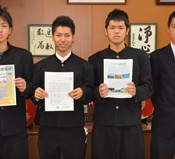
January 3, 2014 Ryukyu Shimpo
Yaeyama Norin High School Civil Engineering Department Environmental Engineering Project Team made it to the final in the Student Project Division for the Low-carbon Championship 2014. Groups, companies and schools nationwide presented their projects for preventing global warming in the championship. On February 14 and 15, four students will take part in the final presentation at Tokyo Big Sight.
Yaeyama Norin High School Team will present its project with the theme of “Protect Yaeyama’s nature by recycling wood! We build a low-carbon society by creative design and manufacturing.” They will present a project that makes playground equipment out of timber from forest thinning and discarded cardboard to pre-schools. They promote recycling society by effectively using forest and bark for dyeing and growing mushrooms.
The school has been contributing to a local community by effectively using experimental forests from three years ago. They will highlight the practical achievements of the projects in the final.
The championship had applications from 1,620 groups, with 11 groups from the student project division in the final. High-ranking groups will win Environment Minister Awards.
Team leader and senior student Daiki Sunagawa stated, “I would like to listen to other schools’ presentations carefully and teach them to junior students.” A junior student Syukyu Shimabukuro said, “I want to understand how the project is passed down from seniors, and to present it to impress other groups.”
(English translation by T&CT and Megumi Chibana)
Go to Japanese
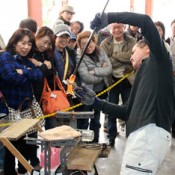
January 5, 2013 Ryukyu Shimpo
A sculpted-glass horse that vigorously holds its front feet in the air, is popular. This year’s zodiac sign is the horse. Naoya Oshiro, head of the Forest Glass Museum in Bimata district of Nago, creates the sculptures.
Oshiro twisted heated glass using scissors and a pallet to make the sculpture. It takes less than a minute.
The visitors gasped in surprise seeing how quickly the work is done.
Based on glass forming techniques from overseas, Oshiro developed his way after three years of trial and error. He started selling the products at the end of 2013. Besides a horse, he creates a cat and rising dragon.

A sculpted-glass horse that looks like it’s starting to run.
Oshiro said, “Even though it needs concentration to create, I am used to it.” He continued to sculpt animals out of heated glass in front of the tourists to the museum.
They erupted into applause upon seeing the quickly sculpted horses.
Oshiro smilingly said, “It is great to see the visitors enjoy themselves.”
(English translation by T&CT)
Go to Japanese
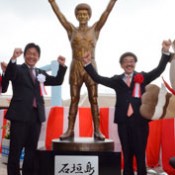
December 31, 2013 Ryukyu Shimpo
Ishigaki City Office has erected a bronze statue of Yoko Gushiken, former world boxing champion from Ishigaki, in Ishigaki Port Rito Terminal on December 26.
Gushiken took part in the unveiling ceremony. Seeing the statue depicting him in his prime, he spoke with deep feeling.
Wearing the champion’s belt, the statue holds his hands with gloves in the air. It is about 170 centimeters high, slightly bigger than himself. The physique and facial expression reflect Gushiken in his prime.
Although Gushiken looks calm and collected as a TV personality these days, the statue depicts his powerful figure. Known by the nickname Fierce Eagle, the former WBA Light Flyweight champion made 13 title defenses, a record for Japanese world champions.
Gushiken appeared at the ceremony with his ring entrance music Conquistador. He said, “I am overwhelmed. I am happy to cry and grateful to the Ishigaki citizens.”
The office erected the statue at the place where Gushiken boarded a ship to go to the main island of Okinawa when he was 15 years old. Gushiken said, “I boarded the ship to move to the main island of Okinawa and became the world champion. I am happy to see the statue depicting me in my prime at this place.”
After the ceremony, Gushiken took commemorative photographs with tourists and the citizens in front of the statue.
The office created the statue for the project to promote a new Ishigaki tourist spot called “Monument that makes want to take a photograph.”
(English translation by T&CT)
Go to Japanese











 Webcam(Kokusai Street)
Webcam(Kokusai Street)


